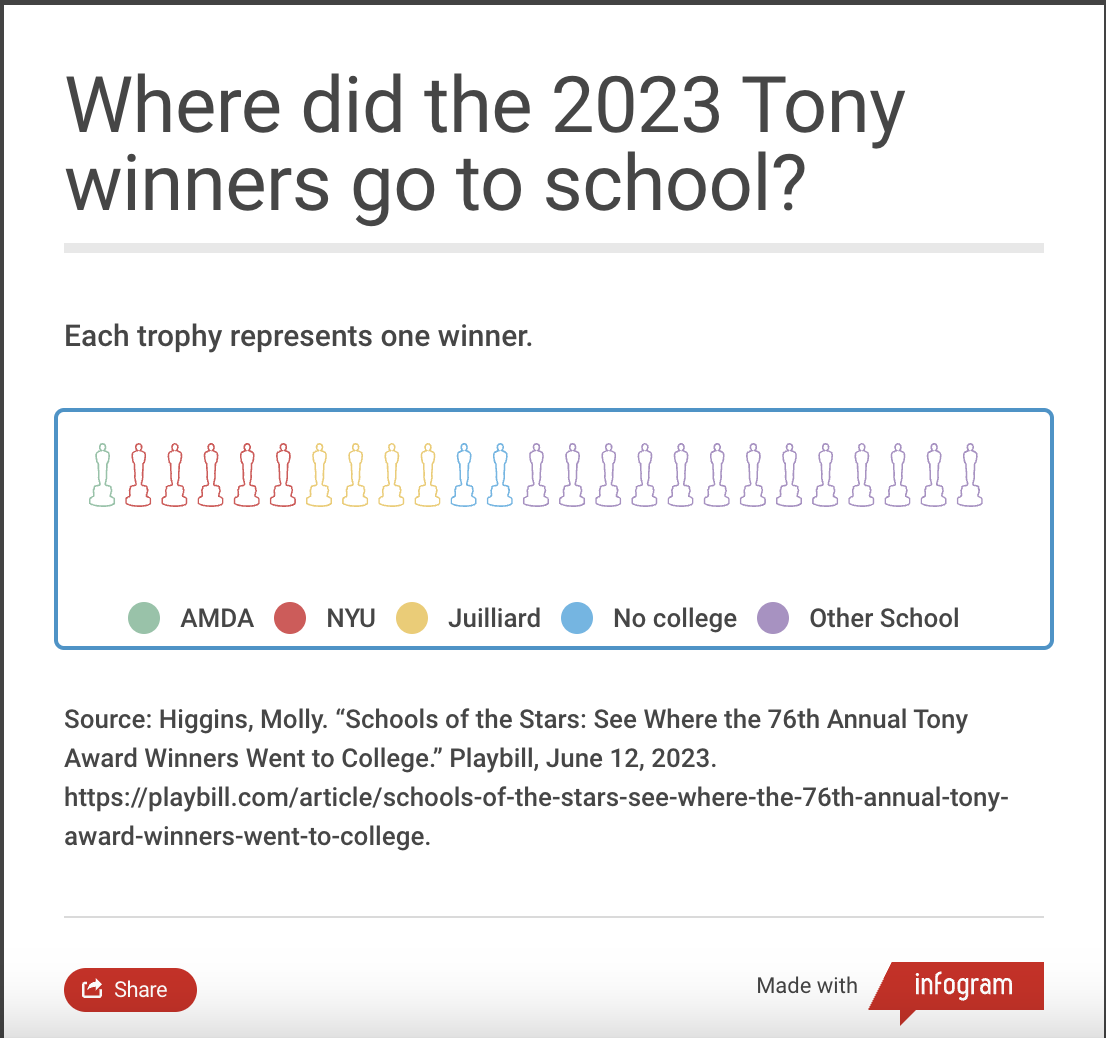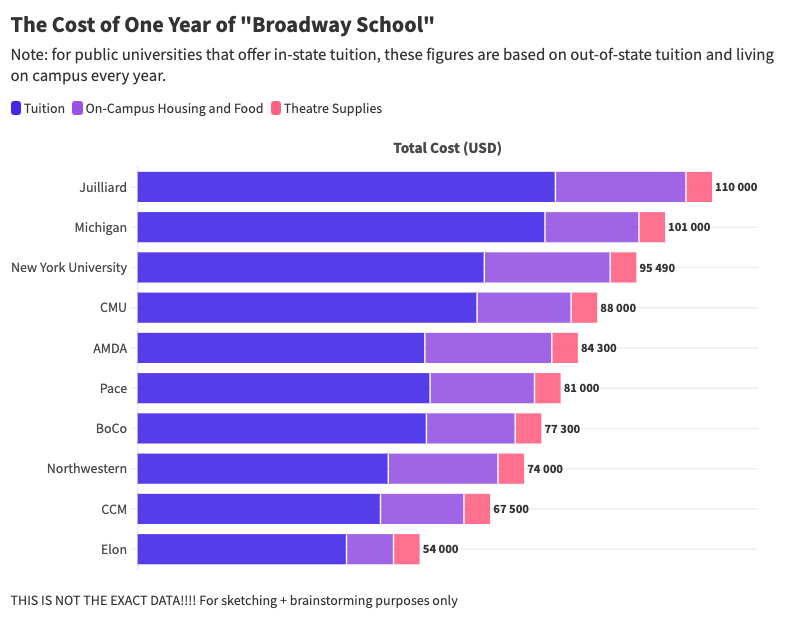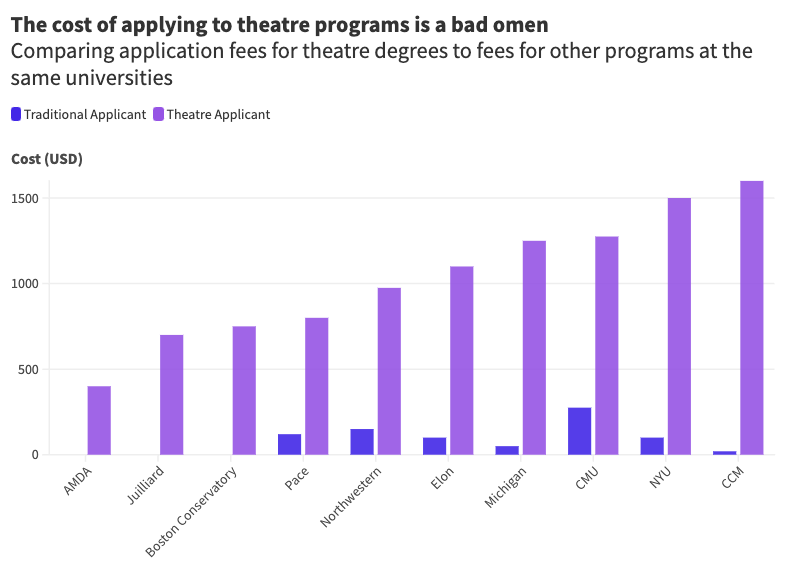tswd-portfolio-fall23
| home page | visualizing government debt | critique by design | final project I | final project II | final project III |
Outline
Every year, thousands of high school seniors across the United States, and a privileged few from countries across the globe, participate in what laymen could only describe as the closest possible experience to a human cattle-call: the musical theatre college audition process. From campus visits to testing to prescreens and the final audition, the process can cost thousands of dollars for an auditioner and their family, even without additional support such as coaching or a summer intensive program. While, of course, institutional and governmental financial aid is available, these are not resources that are available to all students during their process and education.
Playbill, a theatre magazine perhaps most famous for its iconic programs that are featured in many an Instagram story, releases an annual report of the top 10 colleges and universities represented on Broadway from the previous year. The messaging of the best theatre schools is reinforced each year around June when Playbill releases another article on where that year’s Tony Award-winning actors, directors, and designers went to college. Many high school students hoping to make it in the business start their college search here- but what is the true cost of a musical theatre degree from one of these institutions?
And how does the cost of training feed into the homogenization of actors on Broadway? In fact, the industry is becoming more homogenized than the United States; an Actor’s Equity study shows that 63.95% of all union contracts from 2016-2019 went to white actors (Conley et al. 2023) compared to a 61.6% saturation of white people living in the US reported in the 2020 census (Jones et al. 2021). When you also take into account that the acceptance rate at Harvard’s MEDICAL SCHOOL is higher than the acceptance rate of Michigan’s musical theatre program (Edwards 2015), is the elitism fostered by the audition process having impacts elsewhere?
I went through this process myself in 2017 for the 2018-19 school year and ended up at another very selective university, and I can tell you firsthand that it is certainly not a feat for the weak. I hope to be able to provide some of my own story as insight into this experience, but it’s also incredibly important to note that each student’s experience and circumstances are unique. I just want to shed light on SOME of the factors that impacted my experience that are common to all auditioners.
Project Structure
I plan to tell my story in three parts.
The Cost to Get Seen
First, I want to find a way to illustrate the common expenses a musical theatre college auditioner will have to incur on top of typical college application fees (separate audition fees, travel, coaching, dance clothes, printed headshots). I plan to illustrate this through my own journey and comparing it to the costs of applying to other “prestigious” universities with similar acceptance rates (Ivy Leagues, MIT, etc), or to the the costs of applying at the same schools, where applicable, for another program outside of theatre.
How to Stay in The Room Where It Happens
Next, I want to outline annual attendance costs at the top 10 schools represented on Broadway in the most recent Broadway season. For the purposes of an equal playing field, I will end up swapping out Yale for one of the honorable mention schools on the list, as Yale is a Master’s program. Attendance is not limited to tuition, however. This also includes room and board, specialized supplies, and the additional costs outside of the general tuition for another degree that theatre students incur. I may also branch this into the dropout/transfer rates of in BFA programs- I may use my own graduating class for this as we had a number of students drop out, and a number of them were due to cost.
Are These Programs Creating More Problems?
Finally, I want to shed light on the issues of representation in the industry and how some of the barriers present in the audition process are contributing to these inequities. With the end of affirmative action, specialized programs that rely on diversity as a recruiting tool will be forced to face the music. Which of these prestigious schools will remain spaces where culture and diversity can thrive? “Success” is looking more and more white, with 80% of the lead roles in musicals and 90% of the lead roles in plays being played by white actors in the 2018-19 season (The Asian American Performers Action Coalition 2021).
First, I want to use a pictogram to represent the amount of Tony Award winners from the last five years, but I am debating if I want to break it down by school or by the “top 10” schools versus elsewhere.
My call to action would be to the administrations of these schools to re-evaluate the costs of their screening and application processes and to patrons of the arts to invest in the future of musical theatre by donating to an organization like The Fund for College Auditions that dedicates its work to leveling the playing field for students that may come from multicultural or lower-income backgrounds who also battle systemic bias when they enter the audition room. It also may be valuable for a young person looking to go into musical theatre and their families to see the data to make an informed decision on their own process.
Initial sketches
Here are some rough visualizations I’ve created in Flourish and Infogram that I’m planning to polish to accurately represent the data. NONE of this data is exact or accurate, these are just ballpark numbers for the purposes of sketching and brainstorming.




The data
I plan on using sources from Playbill.com, publicly available data on tuition for both academic programs and other resources available to young actors, academic acceptance rates, census data, and personal anecdotes/first-hand experiences to guide this project. The more “academic” data will be used towards the middle of my story, where I am using data to not only prove my point, but also display the gravity of the problem to those who may not be aware.
Actor’s Equity Study - This is where I’m looking for datasets that reflect the current state of the industry and what students can prepare for on graduation. The STAR app will really be my homebase for current college audition data, such as prescreen requirements/costs, audition fees, and application fees. This database will let me really hone in my search to the specifics of the 10 schools I choose. Playbill.com Top 10 List is where I have started my search, and the annual release of this list each year is what made me decide on this topic. AAPAC Study is another resource I will be leaning on for data about representation in the industry, specifically on the basis of racial equity. This will be key to tie in with my discussion on the end of affirmative action and how Best Universities will be where I pull my list of other prestigious universities with similarly competitive acceptance rates and compare them rank-for-rank with the theatre schools. My current visualization comparing costs is for theatre vs. non-theatre degrees, but I may use the ranking system instead. I’ve also found this dataset from College Board that highlights the overall rise in college tuition, which I may use to benchmark some of the tuition costs.
Method and medium
Of course, my first step is to make a final decision on what figures I want to represent in my story. I think there’s a lot to this topic that I could probably do two or even three projects worth of work on it, so I need to really narrow down my scope. I plan to use Flourish and Infogram to build out my data visualizations. I personally LOVE an infographic, and I don’t feel like we have really had the chance to use them in this class, so I’m excited to be able to use a slightly more creative medium to show data in conjunction with charts. I then plan to use Shorthand to thread the whole story together and publish my final project.
Bibliography for Part 1 Cited Sources
Conley, Danee, Russell Lehrer, David Levy, Rachel Goldfarb, and Sidney Wegener. “Hiring Bias and Wage Gaps in 2021.” Actor’s Equity Association, 2023. https://cdn.actorsequity.org/docs/HiringBiasWageGaps2021.pdf.
Edwards, Matt. “Harvard Med School or Mt at U. of Mich. – Which Is Easier to Get Into?” The College Audition Blog, April 6, 2015. https://auditioningforcollege.com/2015/04/05/harvard-med-school-or-mt-at-u-of-mich-which-is-easier-to-get-into/.
Jones, Nicholas, Rachel Marks, Roberto Ramirez, and Merarys Rios-Vargas. “2020 Census Illuminates Racial and Ethnic Composition of the Country.” Census.gov, June 10, 2022. https://www.census.gov/library/stories/2021/08/improved-race-ethnicity-measures-reveal-united-states-population-much-more-multiracial.html. Originally published August 12, 2021.
“THE VISIBILITY REPORT: RACIAL REPRESENTATION ON NEW YORK CITY STAGES- 2018-2019.” The Asian American Performers Action Coalition, 2021. http://www.aapacnyc.org/2018-2019.html.